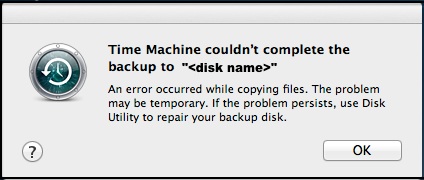Time Machine - Troubleshooting
C3. ". . . an error occurred while copying files . . ."
or "Aborting backup because indexing a file failed"
Time Machine - Troubleshooting
C3. ". . . an error occurred while copying files . . ."
or "Aborting backup because indexing a file failed"

If the next one fails also, then most likely something IS wrong -- the question is, what?
Get the Time Machine Buddy messages (see item #A1). Look for the message(s) about a file that couldn't be copied, such as:
Error: (-nn) SrcErr:YES Copying {a file path} to {"null" or another file path}
or Indexing a file failed. Returned -12 for: {a file path}, {another file path}
(If you find Error: (2) setxattr for key:com.apple.backupd.SnapshotVolumeUUID . . ., see the yellow box below.)
If you're not familiar with file "paths," it can be a little difficult to read these messages. They look something like this:
/Users/<Name>/iMovie Events.localized/clip-2008-04-02.mov to /Volumes/TM Backups/ . . . etc.
The end of the file in question is usually indicated either by " to " or just a comma and space before the next one.
If it's a file you're sure you don't need, you can delete it. If not, for now, don't touch it. Instead, exclude it from backups:
•Go to Time Machine Preferences and click Options.
•In the next panel, click the plus sign at the bottom.
•In the sidebar of the next panel, select your computer name, internal HD, or home folder as necessary; then navigate to the file listed, or, perhaps, its enclosing folder.
If you can't find the item, and its name starts with a dot (period), or it's a top-level folder that doesn't appear, it's a hidden item. Click the Show invisible items box to make it appear.
See Frequently Asked Question #10 if you have difficulty with this.
•Select it, click Exclude, then Done.
•Then do a Back Up Now from the Time Machine icon in your Menubar, or by right-clicking the Time Machine icon in your dock.
If the backup runs ok, then you need to figure out what's wrong with that file.
If it fails again, check the new messages. If it's the exact same file, you didn't exclude the right one, or you need to do a "full reset" (see item #A4).
If you get the same message for a different file, you may need stronger stuff:
•Exclude your Time Machine disk from any anti-virus scanning.
•If you're on Snow Leopard or Leopard, or if there's anything besides backups on your backup drive, also exclude it from Spotlight indexing, at least temporarily, via System Preferences > Spotlight > Privacy.
•Repair your backups, per item #A5.
•If the original file is on an external disk, Repair it, too.
•If the original file is on your internal HD (your boot drive), Verify it, per item #A5.
•If you're getting Error: (-36) SrcErr:NO Copying ... errors while backing-up to an external HD, try connecting it to different ports, via different cables, and different combinations of ports and cables. (A plug that works fine in one port may not make good, consistent contact in another one.) Make sure all connections are snug and secure.
•If you have a multi-interface drive (such as USB and FireWire), try the other interface.
•If nothing above helps, you may have a problem with the drive, or communicating with it. Try the suggestions in the green box in item #D2.
•If all else fails, something in your installation of OSX may be damaged. Try installing the "combo" update. If that doesn't help, reinstalling OSX (that won't disturb anything else), per the same page, might do it.
If you see Error: (2) setxattr for key:com.apple.backupd.SnapshotVolumeUUID . . ., check the name of the volume (disk or partition) being backed-up. If it has a slash in the name, that's the cause: slashes are not allowed in volume names. The volume in question will be named towards the end of the message; for example, iTunes/Photos here:
Error: (2) setxattr for key:com.apple.backupd.SnapshotVolumeUUID path:/Volumes/Backup/Backups.backupdb/<Computer Name>/2011-10-10-175239.inProgress/17B95282-E129-473F-812F-4B3D481772B9/iTunes/Photos size:37
Under most circumstances, that's not a problem, but when a "deep scan" ("deep traversal" on Leopard or Snow Leopard) is required, the backup will fail with this message.
Disk Utility won't let you put a slash in a volume name, but the Finder, unfortunately, will.
The fix is easy; just rename the volume, omitting the slash -- use a space or comma or different name. Right-click the volume in a Finder sidebar and select the rename option.